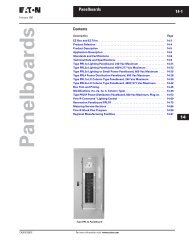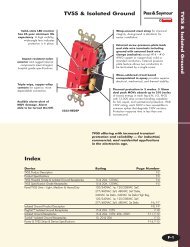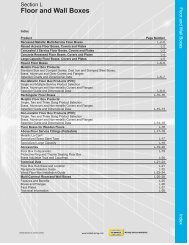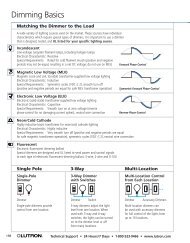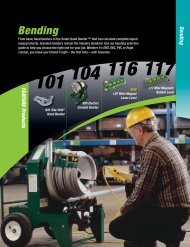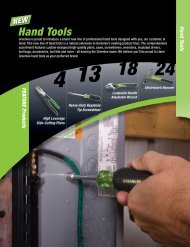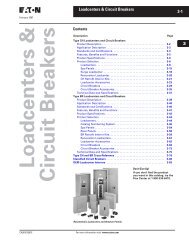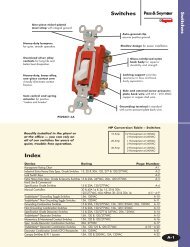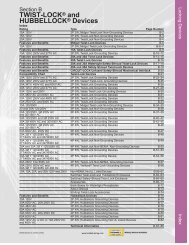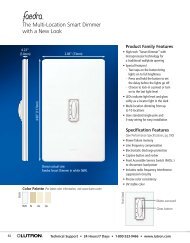Leviton Catalog - Womack Electric Supply Company
Leviton Catalog - Womack Electric Supply Company
Leviton Catalog - Womack Electric Supply Company
- No tags were found...
You also want an ePaper? Increase the reach of your titles
YUMPU automatically turns print PDFs into web optimized ePapers that Google loves.
TECHNICAL INFORMATIONGlossary of <strong>Electric</strong>al Wiring Device TermsTechnical InformationDoor — A momentary contact switch, usually installed on a doorjamb, that isactivated when the door is opened or closed.Double-Pole, Single-Throw (DPST)— A switch that makes or breaks the connectionof two circuit conductors in a single branch circuit. This switch has four terminalscrews and ON/OFF markings.Double-Pole, Double-Throw (DPDT) — A switch that makes or breaks theconnection of two conductors to two separate circuits. This switch has six terminalscrews and is available in both momentary and maintained contact versions,and may also have a center OFF position.Feed-Through — An in-line switch that can be attached at any point on a length offlexible cord to provide switching control of attached equipment.Flush-Mounted — A switch designed for flush installation with the surface of a panelor equipment.Four-Way — A switch used in conjunction with two 3-Way switches to control asingle load (such as a light fixture) from three or more locations. This switch hasfour terminal screws and no ON/OFF marking.Horsepower Rated — A switch with a marked horsepower rating, intended for use inswitching motor loads.Interchangeable — A switch or combination of switches with a common mountingdimension that may be installed on a single or multiple-opening mounting strap.Lighted Handle — A switch with an integral lamp in its actuator (toggle, rocker orpushbutton) that illuminates when the switch is connected to an energized circuitand the actuator is in the OFF position.Locking — A switch equipped with a locking mechanism that requires a key tooperate the switching functions.Low-Voltage — A switch rated for use on low-voltage circuits of 50 volts or less.L-Rated — A switch specially designated with the letter “L” in its rating that is ratedfor controlling tungsten filament lamps on AC circuits only.Maintained Contact — A switch where the actuator (toggle, rocker, pushbutton orkey mechanism) makes and retains circuit contact when moved to the ON position.The contacts will only be opened when the actuator is manually moved to the OFFposition. Ordinary light switches are maintained contact switches.Manual Motor Controller — A switch designed for controlling small DC or AC motorloads, without overload protection.Mercury — A type of switch that uses mercury as the contact means for makingand breaking an electrical circuit.Momentary Contact — A switch that makes circuit contact only as long as theactuator (toggle, rocker, pushbutton or key mechanism) is held in the ON position,after which it returns automatically to the OFF position. This is a “NormallyOpen” switch. A “Normally Closed” switch will break circuit contact as long as itis held in the OFF position, and then automatically return to the ON position.Available in “Center OFF” versions with both Momentary ON and Momentary OFFpositions.Pendant — A type of switch designed for installation at the end of a length ofportable cord or cable,Pilot Light — A switch with an integral lamp in its actuator (toggle, rocker or pushbutton)that illuminates when the switch is connected to an energized circuit andthe actuator is in the ON position.Pull — A switch where the making or breaking of contacts is controlled by pullingdownward or outward on the actuator mechanism.Push Button — A switch with an actuator mechanism that is operated bydepressing a button.Rotary — A switch where rotating the actuator in a clockwise direction makes thecircuit connection, and then rotating the actuator in either the same or oppositedirection breaks the connection.Single-Pole, Double-Throw (SPDT) — A switch that makes or breaks the connectionof a single conductor with either of two other single conductors. This switch has 3terminal screws, and is commonly used in pairs and called a “Three-Way” switch.Single-Pole, Single-Throw (SPST) — A switch that makes or breaks theconnection of a single conductor in a single branch circuit. This switch has twoscrew terminals and ON/OFF designations. It is commonly referred to as a“Single-Pole” Switch.Slide — A switch with a slide-action actuator for making or breaking circuit contact.Dimmer switches and fan speed controls are also available with slide-actionmechanisms for lighting and fan speed controlSurface-Mounted — Any switch that mounts on a flat or plane surface.Three-Position, Center OFF — A two circuit switch, either maintained or momentarycontact, where the OFF position is designated as the center position of theactuator.Three-Way — A switch, always used in pairs, that controls a single load such as alight fixture from two locations. This switch has three terminal screws and has noON/OFF marking.Time Delay — A switch with an integral mechanism or electronic circuit that willautomatically switch a load OFF at a predetermined time interval.Timer — A switch with an integral mechanism or electronic circuit that can be set toswitch an electrical load ON at a predetermined time.Toggle — A switch with a lever-type actuator that makes or breaks switch contact asits position is changed.T-Rated — A switch specially designated with the letter “T” in its rating that is ratedfor controlling tungsten filament lamps on direct current (DC) or alternating current(AC) circuits.WallplatesCombination — A multiple- gang wallplate with openings in each gang toaccommodate different devices.Decora ® — Wallplates with Decora-size openings for compatibility with <strong>Leviton</strong>’sentire line of Decora devices. Available in a variety of multiple-gang configurations.Screwless-design snap-on versions also available.Flush — A wallplate designed for flush-mounting with wall surfaces or the planesurfaces of electrical equipment.Gang — A term that describes the number of devices a wallplate is sized to fit (i.e.“2- gang” designates two devices).Midway — Wallplates that are approx. 3 /8" higher and wider than the standardsize that can be mounted onto larger volume outlet boxes and/or used to hidewall surface irregularities. These wallplates are approx. 1 /4" deep to ensure aproper fit when used with protruding devices.Oversized — Wallplates that are approx. 3 /4" higher and wider than the standardsize and are used to conceal greater wall irregularities than those hidden by Midwaywallplates. These wallplates are approx. 1 /4" deep to ensure a proper fit when usedwith protruding devices.Modular — Individual-section wallplates with different openings that can beconfigured into a multi-gang plate.Multi-Gang — A wallplate that has two or more gangs.Tandem — A wallplate with individual gangs arranged vertically one above the other.Weatherproof (with Cover Closed) — A UL Listed cover that meets specific test standardsfor use in wet and damp locations with the cover closed.Weatherproof (with Cover Open) — A UL Listed cover that meets specific test standardsfor use in wet and damp locations with the cover open or closed.Surge SuppressionClamping Voltage — The peak voltage that can be measured after a SurgeProtective Device has limited or “clamped” a transient voltage surge.Clamping voltage must be determined by using IEEE Standard C62 testing andevaluated by UL Standard 1449.Joule Rating — The measurement of a Surge Protective Device’s ability to absorbheat energy created by transient surges. Note that the Joule rating is not a part ofIEEE or UL Standards. It is not as significant a specification as Clamping Voltage,Maximum Surge Current and other parameters recognized by these agencies.Transient Voltage Surges — High-speed, high-energy electrical disturbancespresent on AC power lines and data and communication lines, generated by utilityswitching, motor-load switching and lightning strikes.Response Time — The interval of time it takes for a surge protective device to reactto a transient voltage surge. Note that this parameter is not a part of IEEE or ULStandards and is only based on estimations made by manufacturers.Surge Protective Device — See “Transient Voltage Surge Suppressor (TVSS)”definition.Transient Voltage Surge Suppressor (TVSS) — A device designed to protect sensitiveelectronic equipment such as computers and computer peripherals, logiccontrols, audio/video equipment and a wide range of microprocessor-based(computer chip) equipment from the harmful effects of transient voltage surges.Also referred to as a Surge Protective Device (SPD).Maximum (Peak) Surge Current — The peak surge current a Surge ProtectiveDevice can withstand, based on IEEE Standard C62.45 test waveforms.MOV (Metal Oxide Varistor) — The primary component used in most SurgeProtective Devices to clamp down transient voltages.UL 1449 Listing — The industry standard for Surge Protective Devices. A SurgeProtective Device must have a UL 1449 Surge Suppression rating on its label inorder to verify that the device has been tested with IEEE standardized waveforms.Devices without this identification should not be considered reliable surgeprotective devices.V10To learn more about <strong>Leviton</strong>’s outstanding offering of devices visit our Website at: www.leviton.com



